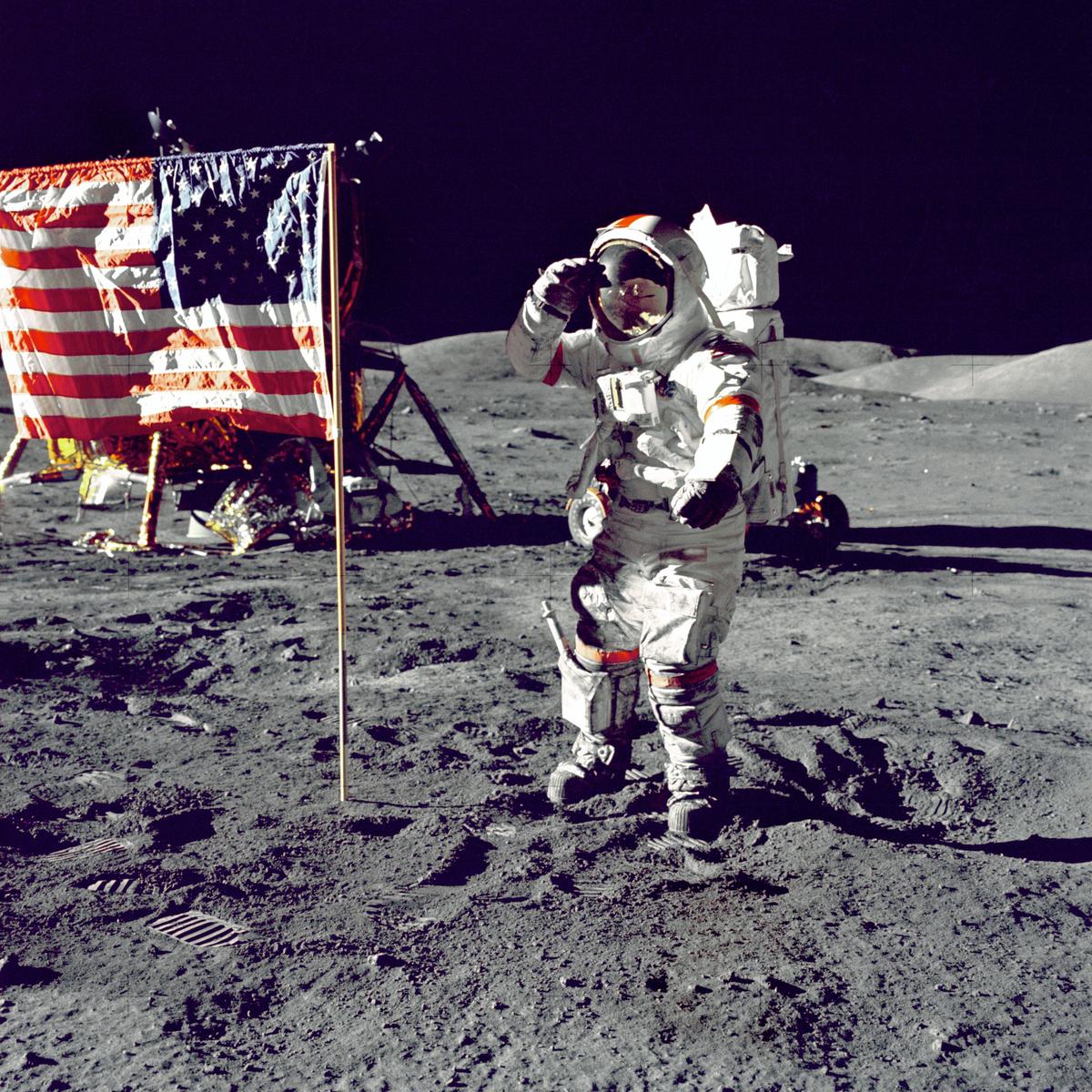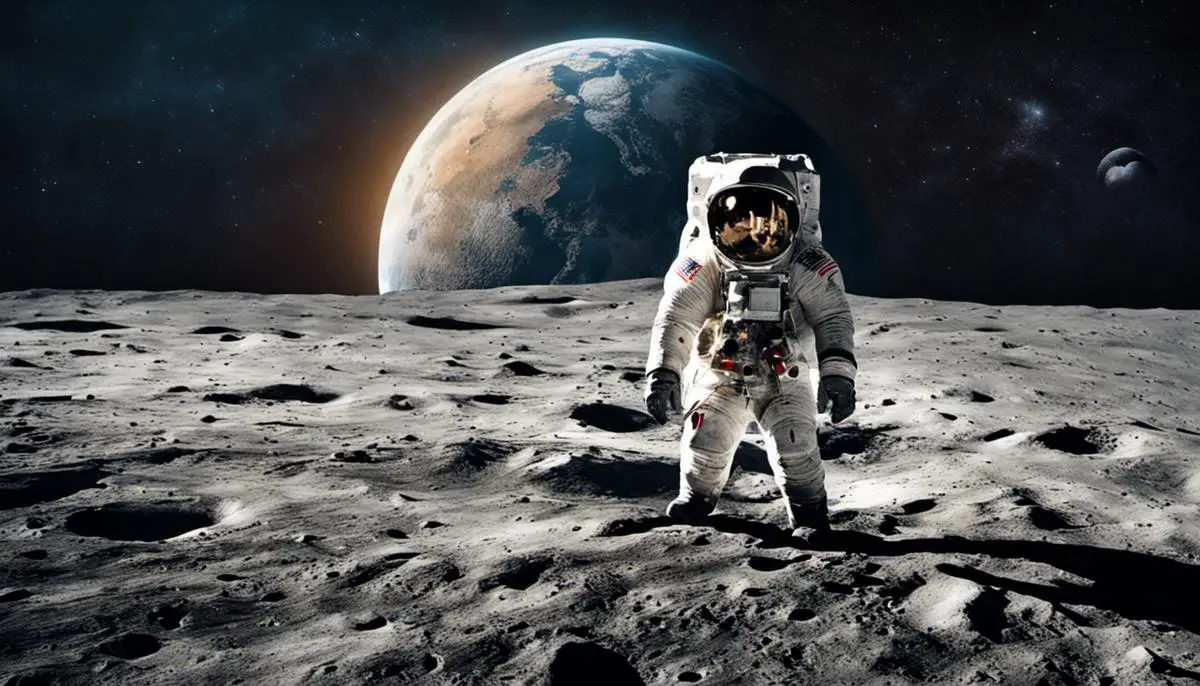The lunar landings of the 20th century, a pivotal time in human history, represents a giant leap that forever changed the way we see our place in the cosmos. This event has had profound effects on space exploration, both directly and indirectly. Embedded in the narrative of the United States and USSR space race, the accomplishment of landing humans on the moon set new milestones for what humanity could achieve. The Apollo Program, under the banner of NASA, engineered this historic feat with its audacious missions, notably Apollo 11. This overview explores the genesis, the players, and the missions that turned lunar landings from fantasy into reality. Alongside shedding a light on the historical context, the impact of the missions on technology, science and society will also be delved into, setting the stage for understanding how these landmark lunar landings have cast a long shadow on future of space exploration.
Contents
Historical Context and Overview of Lunar Landings
Historical Context and Overview of Lunar Landings
The historical backdrop of lunar landings is intertwined with the intense ideological, political, and technological competition between the United States and the Soviet Union, famously known as the space race. The initial catalyst for this rivalry was the launch of Sputnik-1, the world’s first artificial satellite, by the Soviet Union in 1957. This event heightened geopolitical tensions and led to the formation of the National Aeronautics and Space Administration (NASA) by the United States in 1958.
In 1961, amidst a climate of Cold War antagonism and striving to assert dominance in space technology, President John F. Kennedy announced the ambitious goal of safely landing a man on the moon before the end of the decade. This audacious proclamation led to the inception of NASA’s Apollo Program.
The Apollo Program and Its Key People
The Apollo program was a concerted endeavor involving many eminent figures. At the helm was Dr. Robert R. Gilruth, a respected aerospace engineer appointed by NASA to manage the program. The team of astronauts included decorated military personnel like Neil Armstrong, Buzz Aldrin, and Michael Collins. Their dedication, bravery, and technical acumen contributed significantly to the realization of the moon-landing mission.
Missions of the Apollo Program
Integral to the success of the Apollo program were its pre-lunar landing missions, beginning with Apollo 1 in 1967. Sadly, a cabin fire during a launch rehearsal resulted in the tragic loss of three astronauts. Lessons learned from this tragedy were fundamental in ensuring safer designs and operational practices for the upcoming missions.
The program’s most celebrated moment occurred on July 20, 1969, when the Apollo 11 lunar module, Eagle, guided by Neil Armstrong, made a successful landing on the moon. Armstrong’s famous words, “That’s one small step for man, one giant leap for mankind,” as he stepped onto the lunar surface, symbolized the monumental achievement.
Effect of Lunar Landings on Space Exploration
The lunar landings had profound impacts on space exploration. It gave humanity the first tangible evidence of visiting an extraterrestrial landmass. The collected lunar samples have offered valuable insights into the moon’s geology, cosmic processes, and potential resources.
Moreover, the lunar landings fostered advancements in technology and engineering. The intricate requirements to navigate, land, and survive in space necessitated the development of new computer systems, materials, and communications technology. These advancements permeated other sectors, advancing computing, telecommunications, and several industries – a phenomenon popularly termed ‘The Apollo Effect.’
Most importantly, the lunar landings sparked an enduring quest to explore the cosmos. It has since built the groundwork for space missions to Mars and beyond. NASA’s Artemis Program, aiming for a sustainable human presence on the moon, signifies humans’ perpetual ambition for space exploration.
As a result, lunar landings have precipitated a surge in technological innovation, enriched our comprehension of the cosmos, fostered global cooperation, and continue to propel forthcoming generations to conceptualize and mobilize the ensuing stage of human space exploration.

Photo by joehan330 on Unsplash
Technological Advancements Resulting from Lunar Landings
Technological Progress Originating from Lunar Landings
The lunar landing missions, starting with Apollo 11 in 1969, have had significant influence on a multitude of technological progressions, specifically in the area of space exploration and associated technology. The missions mandated the innovation and enhancement of a range of technologies, from flight hardware and software to spacecraft propulsion, materials, and biological life support systems.
A standout technological progression was the creation of the Saturn V rocket, which still retains the title as the most powerful launching vehicle ever employed. Its F-1 engines were an engineering triumph, generating over 1.5 million pounds of thrust. The success of the Saturn V cleared a path for progressions in rocket science and propulsion technology, which continue to make space exploration possible.
The lunar landing further incited enhancement in computer technology. The Apollo Guidance Computer (AGC), cultivated specifically for the Apollo missions, was one of the pioneers in deploying integrated circuits (ICs). In spite of its comparatively weak power to modern calculators, the AGC navigated the Apollo spacecrafts to the moon and back successfully. The miniaturization and hardening of electronics for space travel paved the way for ICs which are now ubiquitous in today’s electronics, including computers, smartphones, and numerous other digital apparatus.
Scientific Contributions and Impact on Earth-Based Tech
The Apollo missions also contributed significantly to scientific knowledge about the moon and the solar system. The moon rocks returned by the Apollo missions have fundamentally changed our understanding about the moon’s geology and the Earth-Moon system’s history. This knowledge is crucial in planning for future manned and unmanned lunar missions and for the broader exploration of our solar system.
Furthermore, many of the technologies developed for lunar missions have found use on Earth, leading to numerous ‘spinoffs’. Some notable examples include advanced materials developed for space suits and spacecrafts that are now used in high-performance sports gear and fire-fighting equipment. Even the process used to purify the air in the Apollo spacecraft has been adapted into a technology used to sterilize hospital rooms. Additionally, the technology to insulate the lunar modules from extreme temperatures was used to develop reflective insulation materials used in buildings.
Re-igniting Interest in Space Exploration
The lunar landing missions also played a significant role in re-igniting interest in space exploration. The success of the Apollo missions sparked interest and investment in further space exploration, leading to missions like Viking, Voyager, and more recent Mars missions. It also spurred international cooperation in space ventures, leading to the creation of the International Space Station.
In recent years, there is a renewed interest in returning to the moon, spurred by private entities like SpaceX and Blue Origin, and international space agencies with the Artemis program.
Historically, lunar landings represent a significant leap forward that ushered in an era of advanced technological development and enthusiastic exploration. These momentous undertakings continue to shape our present-day journey into space and life here on Earth. The successes recorded during the Apollo missions have established benchmarks, providing both knowledge and technological advancements that are central to contemporary space exploration.

Scientific Discoveries and Lunar Research
Noteworthy Scientific Discoveries Birthed by Lunar Landings
The lunar landings catalyzed a seismic shift in our understanding of the moon and the wider universe by enabling in-depth scientific research. Between 1969 and 1972, NASA’s Apollo Program triumphantly executed six moon landings. The groundbreaking maiden lunar landing accomplished by the Apollo 11 mission not only heralded humanity’s potential to venture into space but also sparked a multitude of scientific investigations. The pioneering astronaut team, Neil Armstrong and Buzz Aldrin, gathered approximately 21.5 kilograms of lunar rocks and sediment. Upon scrutiny of these samples, researchers found that, contrary to prior hypotheses, the lunar rock composition deviated significantly from Earth’s.
Insights from Lunar Samples
Meteorological studies of the lunar samples allowed scientists to determine the age of moon rocks, which is approximately 4.5 billion years, aligning with the estimated age of our solar system. The samples provided clues about the moon’s violent geological history. Lack of water and weathering on the moon’s surface has preserved historical cosmic impacts, thus offering a chronological record of meteorite strikes.
The study of lunar rocks also led to the popularization of the Giant Impact Hypothesis. This theory suggests that the moon resulted from a collision between Earth and a Mars-sized body around 4.5 billion years ago. The density and isotopic constitution of lunar rocks and Earth strongly support this theory.
Research Conducted by Astronauts on the Moon
Astronauts conducted a variety of in-situ experiments on the lunar surface. Instrumentation left on the moon by Apollo missions includes seismometers and magnetometers, designed to capture seismic activity and magnetic fields, respectively. It was found that the moon is geologically active, albeit at a much quieter rate when compared to Earth. Moonquakes and the presence of a weak magnetic field were detected.
One of the most remarkable experiments was the Lunar Laser Ranging experiment, where astronauts placed retro-reflectors (special mirrors) on the moon’s surface. Lasers on Earth were then pointed towards these mirrors, and the time taken for the light to return was measured. This experiment provided an accurate Earth-moon distance and confirmed Einstein’s theory of relativity.
The Extensive Contributions of Lunar Research to Space Exploration
Over 50 years have passed since the Apollo missions, yet the lunar samples gathered during these voyages are still offering up fresh discoveries. With the help of advanced technology, such as automated mineralogy and scanning electron microscopes, scientists continue to learn more about the moon’s origins and terrain.
The impact of the successful lunar landings on space exploration was monumental, transforming our perceptions of our celestial neighbor and proving our capacity to venture out and conduct research in unfamiliar territories beyond Earth. This expedition provided valuable wisdom about the moon that has guided planning and technological advancements for numerous space missions.
Whether it’s settling on the moon or exploring other planets, the understanding gleaned from these lunar missions has wide-ranging implications for our space-based ambitions. Most certainly, the continual exploration and study of the moon will only enrich the field of space exploration even further.

Shift in Public Perspective and Culture
Shift in Public Perspective and Culture After the Lunar Landings
The groundbreaking lunar landings led by NASA, which began in 1969, irrevocably altered the public’s perception and culture surrounding space exploration on a global scale. As information about the Apollo missions spread across the world, they fostered a deep sense of accomplishment, fascination, and wonderment in the masses. These successful missions offered a significant shift in public perspective, transforming the concept of space exploration from a seemingly distant and unachievable dream to a tangible and possible reality.
The Apollo lunar journeys played a crucial role in igniting a flame of curiosity and inspiration, especially among the youth. It led to a significant enhancement in the interest in the STEM (science, technology, engineering, and mathematics) fields, as a multitude of students were captivated by the idea of space exploration and aspired to make substantial contributions to this domain in their future professions. The moon landings resulted in a sharp increase in students enrolling in STEM disciplines at universities, further fostering a well-qualified workforce that pushed the envelope of innovation and technological development.
The era also witnessed the rise in the popularity of space-themed media and referencing in pop culture across the nation and the globe. Space exploration themes became a staple in movies, TV shows, books, and music as a reflection and encouragement of the public’s enthralment with the concept of extraterrestrial life. This cultural fascination has stayed alive, maintaining public interest in space exploration, forming the underpinnings for the present wave of private space exploration endeavours.
Furthermore, the moon landing emerged as a cardinal moment during the Cold War, projecting to the public that technological prowess can underscore global leadership. This perception further cemented public backing for government expenditure on space exploration and played an instrumental role in shaping public policy on investment in science and technology.
The lunar landings’ impact stretched beyond education stimulus, inspiration for prospective scientists, and effect on pop culture, giving way to a cultural shift towards a global viewpoint. Immortalized through the iconic “Earthrise” photograph taken during the Apollo 8 mission in 1968, it presented Earth as a delicate and interconnected system, nurturing a common sense of accountability for our planet.
The success of the lunar landings also set the foundation for international cooperation in space exploration. While the Space Race was marked by competitiveness, it steered towards cooperative initiatives like the International Space Station, post the lunar landings. This invited an exchange of knowledge and resources amongst nations, leading to advancements in space technology and research, setting the stage for future space missions.
To summarise, the lunar landings caused considerable ripples in public perspective and culture, from shifting educational and professional aspirations to influencing pop culture and public policy directives. It also initiated a change in the perception of national boundaries, promoting unity and a shared responsibility towards Earth – a significant stepping stone towards international collaboration in space exploration.

Photo by priscilladupreez on Unsplash
Future of Space Exploration
Implications of Lunar Landings for Future Space Exploration
The Apollo moon landing, a momentous occasion in human history, set significant precedents for the future of space exploration. Humans stepping on a celestial body other than Earth for the very first time represented a landmark in our comprehension of the universe. The Apollo missions not only laid strong groundwork for basics of space travel, but they also instigated our thirst to discover more about the cosmos.
Lessons Learned from the Apollo Program
Many critical lessons were learnt from the Apollo program. One major lesson was regarding the importance of developing robust technology. The Apollo program led to the development of technologies such as long-range communication systems, advanced computers, and cutting-edge materials used in space suits and spacecrafts. The landings also taught us the crucial need for extended training for astronauts to withstand harsh lunar environment and conduct scientific research in this unfamiliar territory.
Additionally, Apollo missions also demonstrated that long-term space missions are not only possible but also can be conducted safely and efficiently. This realization paved the way for subsequent space missions and inspired the idea of humans living and working in space, represented by the International Space Station today.
Applying Lessons from Apollo to Present and Future Space Missions
Today, NASA and other international space agencies continue to apply the lessons learned from the Apollo program to present and future space missions. The development of the Orion spacecraft and the Artemis program, which plans to return humans to the Moon by 2024, can trace their origins back to the pioneering work of the Apollo missions. The Artemis program aims to address some of the challenges faced during the Apollo missions, including prolonging human stay on the Moon and encouraging international and commercial partnerships for sustainable space exploration.
Focus on Returning to the Moon and Exploring Mars
Returning to the Moon is seen not only as a nostalgic revisit but also as a stepping stone for future Mars missions. Lunar landings are now viewed as a way of testing technologies, conducting science, and developing the skills and techniques required for the eventual journey to Mars. Technologies and strategies that were once implemented on the Moon are being refined and redesigned for Mars missions, including habitat modules, rovers, and life support systems.
Moreover, exploring the Moon will provide crucial insights about the early solar system, which can likely help understand how planets like Mars evolved over time. The exploration of Mars has been intensified with missions like the Mars Perseverance Rover providing groundbreaking information about possible ancient life on the planet.
The lunar landings were indeed the stepping stones towards much grander goals as they opened our eyes to the immense potential and future of space exploration. Thus, current and future space missions continue to be influenced by the invaluable lessons derived from these historic events.

Indeed, the lunar landings of the late 1960’s and early 70’s continue to resonate within our society, technology, and scientific understanding. They pushed the boundaries of what was technologically possible, led to a myriad of scientific discoveries, and profoundly impacted our culture. Today, the lessons derived from lunar landings are actively shaping future space missions. From moon to Mars, the new generation space missions are leveraging the experiences and outcomes of the Apollo program. As we stand at the new frontier of space exploration, we find ourselves in the debt of these early lunar missions for they have not only expanded our knowledge but also inspired us to dare, to discover, and to reach out for the stars.
